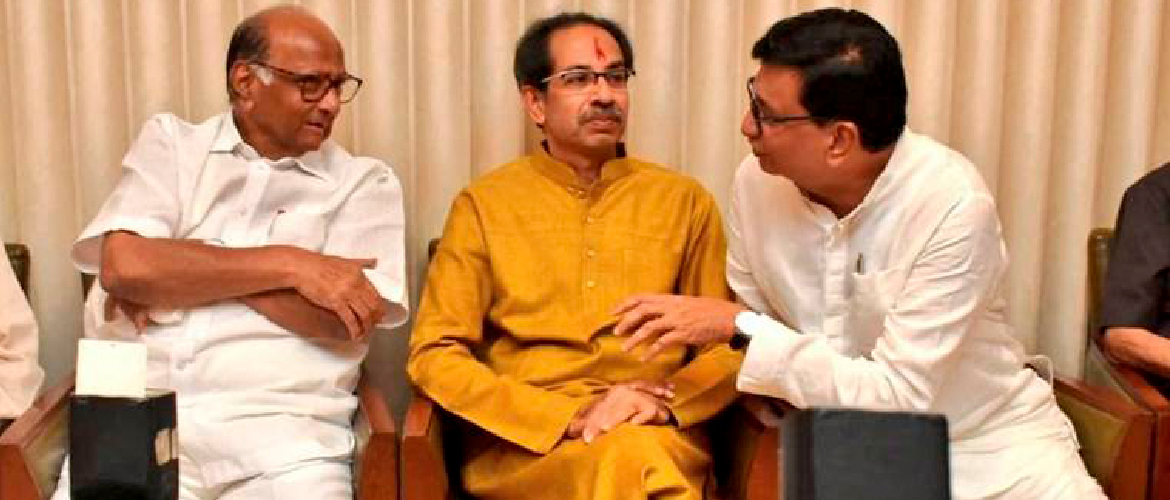The Maharashtra Muddle
December 9, 2019 | Expert Insights
The recent political shenanigans in Maharashtra can potentially be an inflection point in the increasingly unipolar politics of India. Since the 2014 general elections, the ruling Bharatiya Janata Party had firmly established itself the primary pole of Indian politics just as the Congress Party was up until the 1980s. While the party did power in several state elections since, but romped home with a bigger majority in 2019. In Maharashtra too, it should have been in power having won a comfortable if slightly reduced majority in alliance with its longtime partner Shiv Sena. Shiv Sena, the junior partner in the alliance with 56 seats to the BJP’s 105 in a house of 288 walking out of the combine when denied the chief ministership created a classic deadlock. The ideological persuasion of the Shiv Sena and the Congress-Nationalist Congress Party (NCP) are so divergent that their coming together would have defied the laws of nature. But then, the prospect of being in power has the power to surmount all hurdles.
The desperation among all players to be in control of Maharashtra is understandable. Politically, Maharashtra is the second largest state in India, sending 48 members to the Lok Sabha, next only to Uttar Pradesh’s (UP) 80. But its also an economic powerhouse. As India richest state Maharashtra contributes 13% of India’s industrial output; exports $12 billion dollars worth of software; it’s capital Mumbai is the business and financial headquarters of India, and its GDP of $350 billion is comparable to a mid-sized nation such as South Africa. Anyone who rules the state controls enormous financial resources. Unwilling to throw in the towel, the BJP tried to garner support from the opposition ranks, through means not considered kosher and formed a government that was destined to fail given the arithmetic.
Now there is a more stable three-party alliance in office under the rubric of Maharashtra Vikas Aghadi or Maharashtra Development Alliance with Shiv Sena’s Uddhav Thackrey as the Chief Minister. While the BJP’s juggernaut may have been halted in Mumbai, all four parties have had to swallow extremely bitter pills in the process. The BJP already smarting from a loss of nearly 20 seats in 2019 compared to 2014, has risked being seen as willing to make unholy alliances in its botched bid for power. Embracing, even if temporarily, Ajit Pawar, NCP patriarch Sharad Pawar’s nephew who BJP was keen to prosecute under charges of the graft was unalloyed opportunism. The Congress, once the dominant force in the state’s politics is now reduced to being the smallest of the major parties. More than the electoral slide, what must hurt is the necessity to stand shoulder-to-shoulder with Shiv Sena that’s the ideological opposite of the Congress. For a party that claims to uncompromisingly committed to secular values, joining hands with Shiv Sena whose foundations were built on an aggressive assertion of Hindu and Maharashtrian identity must grate. Because of Shiv Sena’s Hindutva ideology, it had until recently remained the BJP’s longtime natural, all-weather ally. The Congress’ odd ideological alliance may dent its secular credentials elsewhere. For the Shiv Sena too, power comes at a potentially huge premium. Could it have abdicated its core electoral constituency of Hindu nationalism? Already, over the last two decades, the BJP from being a junior partner to Shiv Sena had overtaken it as the face of the alliance. Shiv Sena’s founder, the late Bal Thackrey prided himself as the ‘Hindu Hriday Samrat’ or the ruler of Hindu hearts. Having tied up with hitherto staunch rivals Congress and NCP, the Sena risks ceding that sobriquet to Narendra Modi. The challenge before Shiv Sena is to refashion itself as a modern, progressive outfit that can go beyond the narrow appeal of religious and linguistic chauvinism.
From a national perspective, despite upending the spirit of the public mandate which undoubtedly was for the Sena-BJP alliance, the Maharashtra Vikas Aghadi may offer a new template for the opposition to bury ideological hatchets in the quest for denting the BJP’s pre-eminence in politics. For the NCP, this is a lifeline from the brink of irrelevance to occupying the centerstage in Maharashtra.
In all of this, what of the state of Maharashtra and its citizens? Despite the economic heft the state and its capital Mumbai carry, the infrastructure in the state has been creaky for decades. Mumbai city’s governance under the long reign of the Shiv Sena-BJP’s heading the city’s municipal body has been below par, to say the least. While Maharashtra has high levels of industrialization, it has long been blighted by an agricultural crisis. Farmer suicides are rampant in several parts of the state. Almost every year Maharashtra’s farmers take out large rallies in Mumbai demanding loan waivers and better prices for their produce. Despite a common minimum programme and promises of speedy redressal of agrarian issues, a coalition of strange bedfellows is not the perfect recipe for reasonable governance. Having fought bitterly against the Congress and NCP since the time of its birth, the Shiv Sena will find it incredibly hard to work in tandem with the two parties at the grassroots. India’s most economically productive state deserves better than a prolonged period of political uncertainty.
Image Courtesy: indianexpress.com


